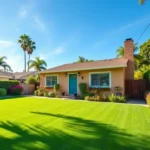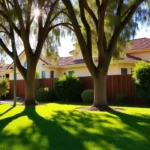A lush, green lawn is a staple of a beautiful landscape, but when it comes to choosing between artificial turf and natural grass, homeowners often find themselves weighing the pros and cons. Both options offer unique benefits, and the best choice depends on factors such as maintenance, cost, environmental impact, and personal preferences. Let’s break down the key differences to help you decide which is right for your yard.
The Case for Artificial Turf
Artificial turf has gained popularity for its durability, low maintenance, and year-round green appearance. Here’s why many homeowners are making the switch:
1. Low Maintenance
One of the biggest advantages of artificial turf is that it requires minimal upkeep. Unlike natural grass, it doesn’t need mowing, watering, fertilizing, or pest control. Simply brushing and rinsing it occasionally keeps it looking fresh.
2. Water Conservation
In regions prone to drought or with high water costs, artificial turf is an excellent option for reducing water consumption. It eliminates the need for regular watering, saving thousands of gallons per year.
3. Durability and Longevity
High-quality artificial turf can last 15-20 years with proper care. It withstands heavy foot traffic, pets, and extreme weather conditions without developing brown patches or bare spots.
4. Aesthetic Appeal
Artificial grass stays green and uniform throughout the year, regardless of weather conditions. Modern advancements have made synthetic grass look and feel more natural than ever before.
5. Allergy-Friendly
For those with grass allergies, artificial turf offers a great alternative by eliminating pollen and other allergens commonly found in natural lawns.
Potential Downsides of Artificial Turf
Higher Initial Cost: The installation cost of artificial turf is higher than seeding or sodding a natural lawn.
Heat Retention: Synthetic grass can become significantly hotter than natural grass in direct sunlight.
Environmental Considerations: While artificial turf saves water, it is made of synthetic materials that may eventually end up in landfills.
The Case for Natural Grass
Natural grass has been the traditional choice for generations, providing a soft, natural feel and environmental benefits. Here’s why many homeowners prefer it:
1. Natural Beauty & Cooling Effect
A well-maintained lawn adds a natural charm to any landscape and helps cool the surrounding area by absorbing heat, unlike synthetic grass, which retains it.
2. Environmental Benefits
Grass absorbs carbon dioxide, releases oxygen, and improves air quality. It also helps reduce runoff by absorbing rainwater, preventing erosion and flooding.
3. Cost-Effective Installation
Compared to artificial turf, natural grass is cheaper to install, whether you choose to seed it or lay sod.
4. Comfortable for Pets & Kids
Many homeowners prefer natural grass because it provides a softer, cooler surface for kids and pets to play on.
Potential Downsides of Natural Grass
High Maintenance: Requires regular mowing, watering, fertilizing, and pest control.
Water Consumption: Can require significant amounts of water, especially in hot climates.
Seasonal Changes: Grass can become patchy, brown, or dormant depending on weather conditions.
Which Option is Right for You?
Choosing between artificial turf and natural grass depends on your priorities:
Go for artificial turf if you want a low-maintenance, water-saving, and long-lasting lawn that stays green year-round.
Opt for natural grass if you value its environmental benefits, enjoy the feel of real grass, and don’t mind regular maintenance.
Conclusion
Both artificial turf and natural grass have their advantages and trade-offs. If water conservation and low maintenance are your top priorities, artificial turf is a great investment. However, if you love the feel of natural grass and are willing to put in the work to maintain it, a traditional lawn may be the better choice.
At LFR Landscape, we specialize in both artificial turf installation and natural grass landscaping. Contact us today to discuss the best option for your property!




